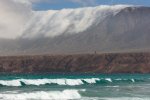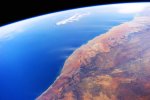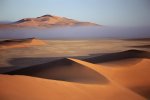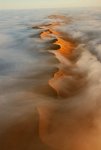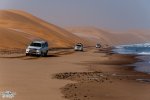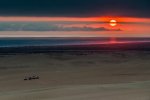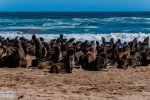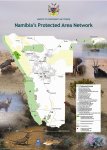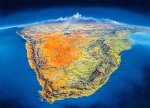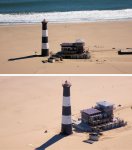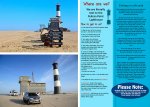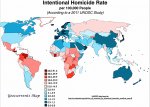.
CONTINUED FROM PREVIOUS POST
****************************************
28. The Ethical Issues raised by TerraLiner Travel through Southern Africa
****************************************
With all that nuance now in place, the overall picture should also be clear. The countries that lie below west equatorial Africa are
not the Congo, and once again, it is simply foolish to imagine the Third World as one unitary, "undifferentiated" bloc.
When countries are ranked instead using a more sophisticated 4-level hierarchy in which "First" through "Fourth World" denotes economic status, and not communist versus capitalist political orientation, Botswana, South Africa, and Nambia all now rank as "
Upper Middle Income" countries, and Angola ranks as "
Lower Middle Income":

For extended discussions earlier in the thread of how outmoded it is to think of the planet in terms of a binary
"First World
versus Third World
" opposition, see posts #226 and #227 on page 23, at
http://www.expeditionportal.com/for...pedition-RV-w-Rigid-Torsion-Free-Frame/page23 ,
http://www.expeditionportal.com/for...igid-Torsion-Free-Frame?p=1586461#post1586461 , and
http://www.expeditionportal.com/for...igid-Torsion-Free-Frame?p=1586462#post1586462 , as well as posts #711 and #712 on page 72, at
http://www.expeditionportal.com/for...pedition-RV-w-Rigid-Torsion-Free-Frame/page72 ,
http://www.expeditionportal.com/for...pedition-RV-w-Rigid-Torsion-Free-Frame/page72 , and
http://www.expeditionportal.com/for...igid-Torsion-Free-Frame?p=1671356#post1671356 .
As suggested in those posts, personally I prefer to categorize countries in a more nuanced way, using a four-tier hierarchy based on the HDI (the Human Development Index), with colors signifying as follows:
HDI dark Green -- the FIRST WORLD
HDI medium, light green,. and light yellow .[and light yellow]
..--.the SECOND.WORLD .[WORLD]
HDI medium yellow and dark yellow -- the THIRD.WORLD
HDI orange, bright red, dark red, and black -- the FOURTH WORLD


The first is a global map of countries classified in terms of HDI for 2009, the second is a map for 2014, and the third and fourth are maps for 2013, with the colors in the first three maps meaning the same thing. Notice how the HDI improved in some African countries between 2009 and 2014 (e.g. Ethiopia, Mali, Niger, Zambia, South Africa), whereas in much of Latin America the HDI actually got worse over the same time period (Mexico, Colombia, Peru, Ecuador, Brazil....)
I prefer to use the HDI, because simply being classified as
"Upper-Middle-Income" is not enough to count as "progressively developing", if most of a country's wealth is still concentrated in the hands of tiny elite, there is virtually no middle class, and most of the population is poor -- see
http://www.economist.com/news/middl...ly-rich-or-poor-not-middle-class-should-worry . It is widely known by statisticians that extreme wealth-outliers can radically skew upwards a country's average or
"arithmetic mean" GDP-per-capita figure, thereby providing a very inaccurate picture of the incomes of most people. See
https://en.wikipedia.org/wiki/Average ,
https://en.wikipedia.org/wiki/Mode_(statistics) , and
https://en.wikipedia.org/wiki/Median . So
"median household income" tends to be a more accurate measure of the wealth or poverty of a typical household, than "GDP per capita" -- see
https://en.wikipedia.org/wiki/Median_household_income .
Southern Africa, Namibia, Botswana, and Angola are all countries with extreme income inequality, with GINI coefficients much worse than the United States, which is really saying something, because the United States is itself a very economically unequal sort of society, comparatively speaking -- see
http://www.theatlantic.com/internat...anks-near-bottom-on-income-inequality/245315/ ,
http://www.theatlantic.com/business...-much-higher-in-the-us-than-in-france/278660/ ,
http://www.theatlantic.com/business...y-its-worse-today-than-it-was-in-1774/262537/ ,
http://www.theatlantic.com/business...arned-about-income-inequality-in-2014/383917/ ,
http://www.theatlantic.com/business/archive/2015/06/what-matters-inequality-or-opportuniy/393272/ ,
http://www.huffingtonpost.com/2013/08/15/income-inequality-wall-street_n_3762422.html , and
http://time.com/3855971/us-economic-inequality/ :

Notice in the second map how the United States is more economically unequal than most of Eurasia, including a relative poor country like India. The United States is also more unequal than most of French West Africa, and the United States is much more unequal than developed Anglosphere countries like Canada, Australia, Britain, Ireland, and New Zealand. Notice how Australia is comparatively
very egalitarian, only just one level below the very high income equality enjoyed by Germany, Austria, and the Scandinavian democracies. Only much of Latin America (although not all) is more economically unequal than the United States, and southern African countries could be described as
"hyper-unequal".
This is not merely a matter of economic justice, but also a matter of economic development: a large middle class in the center is precisely what sustains a high level of overall demand for goods and services in advanced economies. Just one rich person with a gargantuan appetite still cannot produce the same economic demand as 10,000 middle-class shoppers with much more moderate needs. Even a super-excessive rich person can only wear one pair of jeans at a time, and can eat only three expensive meals a day. So African countries will only truly begin to "take off" economically once they become economically more equal as well, and develop sizable middle classes whose aggregate demand provides the internal motor driving the production of goods and services for local consumption.
As former Labor secretary Robert Reich and the Nobel-prize-winning economist Joseph Stiglitz have pointed out, this basic truism applies equally well to an advanced economy like the United States. In the United States flat or even slightly declining middle-class incomes over the last 4 decades -- despite increasing productivity and overall growing GDP -- have become not just an ethical issue or a matter of economic justice, but also an economic problem. Stagnant American middle-class incomes mean stagnant American middle-class demand, which in turns means less economic production, fewer jobs, lower growth, and less prosperity. Even if upper-class greed-motiviated entrepreneurialism is the energy that drives innovation in the American economy, those innovations won't be purchased by very many people unless there also exists a large, growing middle class whose rising incomes enable them to buy the innovations.
****************************************
Still, with those cautionary remarks in place, countries like South Africa, Nambia, Botswana, and Zambia do classify somewhere between Second and Third World, and not as Fourth World, as per the Congo, Mali, Niger, the Central African Republic, Burkina Fasso, Guinea, Sierra Leone, etc. Furthermore, as shown in the previous post, the hyper-inequality in Namibia, Botswana, or Zambia has not (yet) translated into a high crime rate, although perhaps hyper-inegalitarianism and the legacy of Apartheid is one of the causes of South Africa's stratospheric level of criminality. Zambia is an ambiguous case, because although Fourth-World in terms of income, Zambia's HDI is still much better than the Congo's. Mozambique and Tanzania are also interesting cases, because although they have Fourth-World HDIs and per-capita incomes, they are also more egalitarian than the others, and seem relatively safe to travel. Which is why I tentatively suggested "extensions" of the TerraLiner's hypothetical itinerary through southern Africa, passing via Zambia over to Mozambique, and up to Tanzania.
Ergo, most or even all of these Southern African countries -- with the exceptions of South Africa and Zimbabwe -- seem well worth traveling by TerraLiner, and might also be considered "ethical" places for the TerraLiner to travel. The locals in Namibia or Botswana won't be so desperately dirt poor that they will experience the TerraLiner driving through as a slap in the face, as an obscene affront. As far as South Africa and Zimbabwe are concerned, I would need to do a bit more research before coming to a definitive conclusion. For instance, do upper-middle-class South Africans who have First-World incomes and considerable savings, travel the country in Class-A motorhomes, as per those who are wealthier in Australia? Is there an extensive system of RV parks in South Africa, comparable to systems in Australia, the United States, Canada, and Europe? Would it be possible to travel South Africa in a large Class-A motorhome and not have to worry that much about crime, as long as one travels using the RV park system, assuming that one exists?
Glamping farmland is basically my proposed solution to the security problem of traveling with a large, Class-A size motorhome in Second World and Third World countries that lack extensive RV park systems. But South Africa seems an ambiguous case, because part of the population enjoys a First-World level of prosperity, while a much larger proportion of the population is living at a Third-World level.
In any case, if it were feasible for the TerraLiner to glamp South Africa in relative safety (as safe, for instance, as traveling with a Class-A motorhome through the United States), then clearly the network of blue lines for the TerraLiner's hypothetical southern-African itinerary would extend down to Capetown and Port Elizabeth at a minimum. And the TerraLiner's itinerary would most definitely include a sojourn in or near the "
Great Limpopo Transfrontier Park" now in the process of formation, a mega-park that like KAZA-TFCA straddles national borders, and includes Kruger National Park in South Africa -- see
https://en.wikipedia.org/wiki/Great_Limpopo_Transfrontier_Park ,
http://www.peaceparks.org/story.php?pid=1005&mid=1048 ,
http://www.peaceparks.org/tfca.php?pid=19&mid=1005 ,
http://www.peaceparks.org ,
http://www.greatlimpopo.org ,
http://www.greatlimpopo.org/about-gltp/,
http://www.greatlimpopo.org/maps/project-maps/ ,
http://www.sanparks.org/conservation/transfrontier/great_limpopo.php ,
http://www.sanparks.org ,
http://www.southafrica.net/za/en/ar...hafrica.net-great-limpopo-transfrontier-park1 ,
http://www.britannica.com/place/Great-Limpopo-Transfrontier-Park ,
http://www.golimpopo.com/parks/transfrontier-parks/great-limpopo-transfrontier-park ,
http://www.dolimpopo.com ,
http://www.sanparks.org/parks/kruger/ , and
http://www.krugerpark.co.zareat-limpopo-transfrontier-park-south-africa.html :
https://www.youtube.com/watch?v=3mwFMUd1pLU
In many ways, the "ideal" TerraLiner southern Africa itinerary would be a very large circle. Beginning in Walvis Bay or Capetown, where the it would arrive by ship, the TerraLiner would follow a clockwise itinerary that runs Nambia -> Botswana -> Zambia -> Tanzania -> Malawi -> Mozambique -> South-Africa -> Nambia. These are all countries deemed safe to travel, although I still have lingering doubts about South Africa, because its levels of all types of crime are so high.....
If anyone reading this has extensive experience traveling through southern Africa, and would care to comment on the relative safety of Namibia and Botswana versus South Africa, or Botswana versus Zambia, Tanzania, and Mozambique, please post!! I tend to get my news from
The Economist, which in my experience does a fairly good job reporting the socio-economic and political "facts" in a relatively unbiased way.
The Economist is absolutely honest about the levels of violence and economic inequality in the United States, for instance. So it was in
The Economist that I first learned that Botswana and Namibia have become models of southern-African good government and far-sighted economic policies, albeit diamond-mining funded....

-- see
http://www.economist.com/news/middl...inent-governance-and-rule-law-again-law-first ,
http://www.economist.com/node/14699869 ,
http://www.economist.com/news/middl...swana-faces-worrying-times-losing-its-sparkle ,
http://www.economist.com/node/18806159 ,
http://www.economist.com/node/18340509 ,
http://www.economist.com/topics/botswana , and
http://www.economist.com/topics/namibia .
As for Zimbabwe, I've been simply assuming that the country is a complete economic and political wreck, thanks to decades of mis-rule by Mugabe -- see
http://www.economist.com/news/leade...imbabwe-without-robert-mugabe-act-tyrant-dies ,
http://www.economist.com/news/middl...d-weak-rand-may-do-more-decade-sanctions-spur ,
http://www.economist.com/news/middl...ment-free-its-coalition-partner-risks-driving ,
http://country.eiu.com/zimbabwe ,
http://www.economist.com/topics/zimbabwe , and
http://www.economist.com/topics/robert-mugabe . And that until Mugabe dies, Zimbabwe does not have much hope. Once he does die, Zimbabwe will probably go through a period of even greater chaos, after which with any luck it may finally find its way towards a better future.
There's only the remaining problem of ground-water contamination to consider.....
****************************************
29. The Sanitation Issue raised by TerraLiner Travel through Southern Africa
****************************************
The levels of open defecation in these southern African countries -- when understood in terms of people per square mile -- are not even remotely as bad as India's:

However, the population pyramids in these countries are still very much classical pyramids, and today's parents who defecate in the open will be raising 5 or 6 children to do the same. With this in mind, Namibia's current rate of open defecation when expressed as a
percentage of the population, is significant cause for alarm, especially in rural areas:



Even though the overall level of open defecation per square km in Namibia is still low, because the country is so thinly populated, if over 45 % of the general population defecates in the open, and over 60 % of the rural population does as well, then as Nambia's population pyramid works its way upward, and the country sees a dramatic increase in population over the coming decades, the number of people defecating per square km will also increase dramatically. Unless a serious public health initiative intervenes, the rate of open defecation per square km in Namibia is set to skyrocket.
But from the TerraLiner's point of view, given the continuously high level of relative humidity along Nambia's coast, if the TerraLiner were equipped with two AWGs it would have abundant water when glamped there, and not once would it have to draw water from the ground. Stocked up with water obtained from the fog in coastal western Nambia, the TerraLiner's TOAD could then make "forays" into eastern dry Nambia. And the complete TerraLiner could then depart the Namibian coast completely stocked up with freshwater, as it drives to a "base camp" location somewhere in northern Botswana , from where the TOAD would in turn explore southern Angola, Zambia, and (if safe enough) a bit of Zimbabwe. Even if these countries were suffering from epidemics of water-borne diseases caused by rapidly increasing populations and an unfortunate "tradition" of open defecation, the TerraLiner's water-supply could remain clean and fresh.
In short, paradoxically the ultra-dry coast desert of Nambia -- dry from the point of view of rainfall -- might serve as the TerraLiner's watering hole for much of its sojourn in southern Africa.
So I figure that Nambia deserves at least another 15 or 20 posts, at some point over the next few months.....:ylsmoke:.
..When I finally get around to finishing the series of posts on
“Average Annual Relative Humidity Worldwide”, begun on page 146 and following, at
http://www.expeditionportal.com/for...edition-RV-w-Rigid-Torsion-Free-Frame/page146 , I will be writing about Namibia at even greater length!!
****************************************
30. Why Glamp Southern Angola for 3 months? More Surf, Wildlife, and Clean Fog Water
****************************************
Here it's also worth noting that Angola, like Namibia, has great surf, but it's even more "uncharted" territory. The following excellent video was made just a year ago:
[video=vimeo;78853553]https://vimeo.com/78853553 [/video]
As per many videos in this genre, the narrator tries to dramatically "exoticize" a journey through what is actually one of Africa's more recently prosperous and successfully developing countries. He and his mate catch a nice modern
bus, after all, and they drive along paved roads to their coastal destination.
Sure, Angola had a very long civil war that finally ended only in 2002. But since then Angola has had one of the fastest-growing economies in the world, mainly due to an oil and diamond-mining boom -- see
https://en.wikipedia.org/wiki/Angola . Yes, like many African nations, Angola is a massively corrupt and unequal kleptocracy, and Isabel dos Santos, the daughter of Angola's President, has used her political clout to extort stakes in companies that want to invest in Angola, thereby becoming Africa's first female billionaire -- see
https://en.wikipedia.org/wiki/Isabel_dos_Santos ,
http://www.forbes.com/sites/kerryad...-short-route-to-become-africas-richest-woman/ , and
http://www.forbes.com/sites/kerryad...president-is-africas-first-woman-billionaire/.
But Anglola is not the Congo, Luanda looks prosperous and is booming, some of the prosperity is trickling down from the elite level, and China at least has been nudging Angola in a more "economically democratic" direction, massively subsidizing infrastructure and housing construction. The big challenge for Angola will be distributing the oil and diamond-mining wealth more widely, removing all the land mines, and re-establishing Angola's status as southern Africa's breadbasket. But at least the potential is there, and neighboring countries like Botswana and Nambia have demonstrated just how prosperous a southern African country can become, given reasonably good government:
[video=youtube;4QSmRYQBfN4]https://www.youtube.com/watch?v=4QSmRYQBfN4 [/video]
Those still-unsurfed, unknown waves in Angola's desert south look awfully attractive, and it's only too easy to mentally substitute the TerraLiner for the 4x4 SUV in the video, glamped directly on the beaches that these intrepid guys were surfing (about 6 minutes into the video, and following.....

).
I would have to research things further, but the relative humidity and fog along Angola's southern coast is probably very similar to Nambia's Skeleton Coast. A few posts back the last map depicting Southern Africa's comparative aridity provided a detailed outline of the full extent and length of the Namib desert:

According to this map, the Namib desert extends well into Angola, about halfway up the coast between the border with Namibia and the capital city of Luanda. So if relative humidity along the coast of this northernmost stretch of the Namib were more or less the same as relative humidity along the central coastal in Namibia, then southern Angola should also prove ideal country where a TerraLiner equipped with a few AWGs could sojourn at leisure, for many months, never once having to worry about water. Even though rain would be scarce-to-non-existent, the climate would be desert, and the nearest oasis, lake, or stream would be hundreds of kilometers distant, the TerraLiner's owners would not have to water-ration even once......
 ****************************************
****************************************
CONTINUED IN NEXT POST
..



